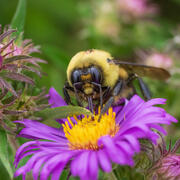Ecosystem biodiversity includes pathogens, which are microorganisms such as bacteria, viruses, and fungi, that can cause disease in animals and humans. USGS science enhances our understanding of the ecology of these pathogen species, including those that significantly affect the health and fitness of wildlife. Some of these pathogens also affect public health, domestic animals, and the agricultural economy. USGS develops decision-support tools and technologies to detect, monitor, assess risk, and control wildlife diseases.
Diseases Causing Pathogens
Water Borne Pathogens and Other Microorganisms
Pathogens in the Environment
USGS Pathogen Science
Science for effective pollinator conservation and improved food security
Michigan Bacteriological Research Core Technology Team
Drinking Water and Wastewater Infrastructure Science Team
Pathogens
U.S. Geological Survey Microbiologist Selected as an American Society for Microbiology Distinguished Lecturer
Interaction of Environmental Stressors and Batrachochytrium dendrobatidis (Bd) Pathogen Loads on Survival of Green Frogs (Lithobates clamitans)
Michigan Bacteriological Research Laboratory
Occurrence of Avian Influenza Virus in Groundwater—Study Provides Baseline Data and Informs Future Studies
USGS Scientists Receive Award for Pioneering Work on White-Nose Syndrome in Bats
Frequent Fliers—Web-Based Tool Aids in Understanding the Role of Wild Birds in Transmission of Avian Influenza
Swine Manure Application as a Source of Hepatitis E Virus and other Livestock-Related Pathogens
Nutrients in Dust from the Sahara Desert cause Microbial Blooms on the East Coast of the United States
New Hepatitis B Virus Discovered in White Sucker (Catostomus commersonii)
Bacterial Pathogen Genes in Streams related to Animal Type and Hydrologic Conditions
Contaminants of Emerging Concern in the Environment
Highly Pathogenic Avian Influenza Detected for the First Time in Wild Birds in North America
Newly Discovered Picornavirus Spread by Baitfish
Skin Lesions and Mortality of Fishes in the Chesapeake Bay Watershed
Ecosystem biodiversity includes pathogens, which are microorganisms such as bacteria, viruses, and fungi, that can cause disease in animals and humans. USGS science enhances our understanding of the ecology of these pathogen species, including those that significantly affect the health and fitness of wildlife. Some of these pathogens also affect public health, domestic animals, and the agricultural economy. USGS develops decision-support tools and technologies to detect, monitor, assess risk, and control wildlife diseases.

















